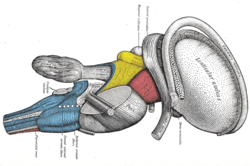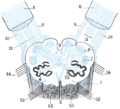Arcuate nucleus (medulla)
| Arcuate nucleus (medulla) | |
|---|---|
 Transverse section of medulla oblongata below the middle of the olive. ("Nucleus arcuatus" visible near bottom right.) | |
 Dissection of brain-stem. Lateral view. (Labels for "External arcuate fibers" and "Dorsal external arcuate fibers" visible at lower right.) | |
| Details | |
| Identifiers | |
| Latin | nucleus arcuatus medullae oblongatae |
| NeuroNames | 775 |
| NeuroLex ID | birnlex_2635 |
| TA98 | A14.1.04.256 |
| TA2 | 6016 |
| FMA | 72609 |
| Anatomical terms of neuroanatomy | |
In the medulla oblongata, the arcuate nucleus is a group of neurons located on the anterior surface of the medullary pyramids. These nuclei are the extension of the pontine nuclei. They receive fibers from the corticospinal tract and send their axons through the anterior external arcuate fibers and striae medullares to the cerebellum via the inferior cerebellar peduncle.
Arcuate nuclei are capable of chemosensitivity and have a proven role in controlling respiratory frequency.
Additional images
-
Diagram showing the course of the arcuate fibers.
-
The formatio reticularis of the medulla oblongata, shown by a transverse section passing through the middle of the olive.
External links


